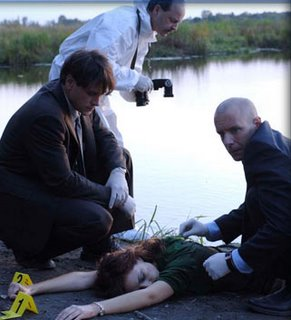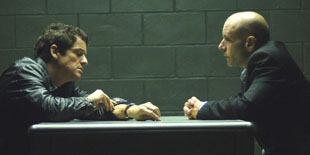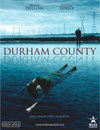Durham County: “HBO can eat its heart out”
by: Michele Byers / Saint Mary’s University

Durham County (DC) is a new offering from the Canadian specialty cable channels Movie Central and The Movie Network.[1] It’s a six-episode series about a cop and a serial killer in the suburbs of Montreal. The series is brought to the screen by the dynamic team of Janice Lundman and Adrienne Mitchell (Talk 16, Talk 19, Straight Up!, Drop the Beat, Bliss), and Laurie Finstad Karzhnik (Cold Squad, Bliss).
DC is a hybrid creature, evidencing what Serra Tinic suggests is an increasing imperative of countries like Canada to create exportable drama (of interest especially to US audiences but stripped of all national and cultural markers)[2] and at the same time exhibiting the Canadian obsession with “Weird Sex and Snowshoes,” “resist[ing] closure, revel[ing] in ambiguity and tend[ing] to defy every rule in the genre handbook.”[3] Shows like DC are meant to compete with shows coming out of the US specialty cable market—The Sopranos, Six Feet Under, and Deadwood—grabbing both audience approval and critical acclaim, as evidenced by the quote I used as the title of this essay.[4] Bart Beaty and Rebecca Sullivan note that many people have seen CanCon laws— which prohibit the licensing of US stations for Canadian broadcast—as protecting the industry from “television viewers [who] would leap at the opportunity to subscribe,”[5] leaving no space for the production of “uniquely” Canadian texts like DC.
DC is an exciting prospect for Canadian television; it employs many of the devices that mark other (US) series as both “quality” and “cult” TV[6]: the “quality” series’ links to “pedigree,” struggle, ensemble, memory, generic hybridity, writely-ness, self-consciousness, controversy, and realism,[7] and the “cult” series’ ability to “support an inexhaustible range of narrative possibilities, inviting, supporting, and rewarding close textual analysis, interpretation, and inventive reformulation.”[8] Despite the mere six hours that make up DC, this text is so rich it’s hard to know how to begin, so I’ll limit myself to a discussion of opening sequences and general structures. By way of comparison, I’ll look at how DC compares to another popular serial killer series: Showtime’s Dexter (Dex, 2006).

DC is about a police officer (Mike Sweeney) who relocates to the Montreal suburbs of his adolescence after the death of his partner and his wife’s remission from cancer. In the ‘burbs he finds himself on the trail of a serial killer (or two), who he believes to be his childhood nemesis and new next door neighbor, Ray Prager. At the same time, Sweeney, it is suggested, is not the good guy he seems to be. This is both like and unlike what we see on Dex. From the very first moments of Dex, Dexter himself tells us about his lack of affect, different-ness, murderous urges. And yet, Dexter Morgan is a moral character who only kills “bad” people as he works to find his place in the world and to make that world “better.” Under his sociopathic exterior is someone with deep feelings, repressed by trauma. On DC we have no real moral guideposts for the characters; it is hard to get into their heads. Ray Prager is a killer, maybe… but maybe Sweeney’s a killer… maybe they both are; their careful surfaces under which violence boils are much less convincingly constructed than that of Dexter Morgan.
The way the two series open tells us a lot about their construction more generally. DC opens with a series of shots which can be read as tableaux. Filmed in black and white with red accents, they say little about the characters or the story about to unfold:
1. Tree branches
2. Manga mask
3. Smoke; a distant city
4. Bald head
5. Wicker basket leaking blood
6. Bald head again
7. Blond curl being nailed to a tree
8. Man in police interrogation room
9. Maquette of a crime scene
10. Aerial view of a suburb with electrical towers
11. Roses floating in water
12. Man dancing with a corpse
13. Man running blind in the dark towards light/camera
14. Man sitting upright in bed
15. Man walking by electrical towers, in sharp cut aways, towards the camera
These images offer a static series of tableaux that may or may not be the story of DC; in fact, they replicate the ambiguity and lack of closure found in the text.

The opening sequence on Dex is about movement, and has a dance-like quality:
1. Mosquito on male arm
2. Thumb on neck
3. Thumb on razor shaving the neck
4. Drops of blood in sink
5. Tissue soaking up blood
6. Piece of ham being cut
7. Ham thrown into hot pan
8. Ham being eaten
9. Egg cracked into pan
10. Egg eaten with hot sauce
11. Coffee beans in grinder
12. Plunger into Bodum coffee press
13. Serrated knife cutting blood orange
14. Orange in handpress
15. White string around fingers
16. Teeth being flossed
17. Cords around hands
18. Shoes being tied
19. Face through white scrim
20. T-shirt pulled over a head
21. Key in door
These are ironic images, each one a double-entendre of banal morning ablutions and murder. They are a key to the series and its central character in a much more specific way than what we see in the opening sequence of DC. The DC tableaux seem to ask us to piece together a story that is never fully forthcoming even after we have seen all 6 episodes. The Dex intro, by contrast, makes a great deal of sense once we have watched just the start of one episode.
In fact, in the first episode of Dex this sequence doesn’t appear at all. At the opening of the first episode, we hear Dexter in voice-over telling us about himself in an ironic way–his killings beside, for example, his love of Cuban food–as he moves through the city of Miami. We see flashbacks to his childhood and adopted father. We see Dexter find his first “victim”—a child murderer—and kill him. Throughout, Dexter provides exposition wherein his moral position is established. We then see him on his boat, on his way to dump garbage bags full of body parts; as he smiles and talks about how good he is at faking human emotion, his “goodness” is already sutured to the viewers.

DC starts with the tableaux described above. The scenes that follow show us, through trees, a man picnicking with two young women in schoolgirl uniforms. It isn’t clear if they are schoolgirls or prostitutes, but the man’s sexual intentions are clear enough. We see an eye, watching, through the trees. We turn back to the people at the picnic, who are shot just as torsos. Then back to the eye. We then cut away to a family in a car, driving out of a city. Then we cut back to the woods. The women are bound and dead or dying, one mouths “help me” to the eye in the woods. The killer is shirtless and it is his body rather than those of the clothed girls that is eroticized for the viewer and the eye in the woods. We cut back to the family, fields of electrical towers and then, in juxtaposition, the big houses of a suburban enclave. In these scenes, the morality of the characters and their position within the world remain deeply ambiguous.
In fact, good and evil are not terms that easily apply to anything on DC. This sense of ambiguity travels into the sexual realm too, with DC seemingly willing to go into particularly “ugly” territory—although it, like most serial killer narratives, is fascinated with the murder of women—leaving open questions of the homoerotic, necrophiliac, and so on. On Dex, by contrast, these routes are closed down through tropes of fraternity and the desire for heterosexual monogamy. Further, where the shocking aspects of violence and blood (or lack of it) are crucial to the visual display of Dex they play only a small role in DC. While Dex is concerned with goodness in the heart of multicultural urban spaces—which are so often presented as dangerous—DC presents us with the dangers at the heart of unerringly white suburbia. The visual quality of the series tells us something too: Miami is filmed in sun, bright colors and loud noises. The suburbs are quiet, muted (filmed through a grey lens), and framed by the ominous, ubiquitous presence of those rows and rows of electrical towers. The city seems to have been produced through history, whereas the suburb is shown to be entirely artificial and unrooted from both history and landscape. Neither are particularly original narrative tropes, but suggest a line of inquiry into the texts and the spaces of their production.
DC may be a hard text to love for many viewers. It offers a constant confounding of visual, textual, and moral expectations. Dex seems to have found itself a well-deserved following of viewers (me included), will the same be true of DC? I can only hope so.
Notes:
[1] [Source for title quote:] “Hugh Dillon Hopes for A Hit with Durham County.” Chart Attack. May 7, 2007. www.chartattack.com
[2] Tinic, Serra. On Location: Canada’s Television Industry in a Global Market. Toronto: University of Toronto Press, 2004.
[3] Monk, Katherine. Weird Sex and Snowshoes and Other Canadian Film Phenomena. Vancouver: Raincoast Books, 2001: 5.
[4] Also see Kelly, Brendan. “Canada turns to Cable for Original TV.” Variety. August 17, 2007. www.variety.com
[5] Beaty, Bart and Rebecca Sullivan. Canadian Television Today. Calgary: University of Calgary Press, 2006: 45.
[6] See for example, Jancovich, Mark and David Lyons, eds. Quality Popular Television. London: Bfi Publications, 2003; Gwellian-Jones, Gwen and Roberta Pearson, eds. Cult Television. Minneapolis: University of Minnesota Press, 2004.
[7] Wilcox, Rhonda and David Lavery. “Introduction.” In Fighting the Forces, edited by R. Wilcox and D. Lavery. Lanham MD: Rowman & Littlefield, 2002: xxi–xxiv.
[8] Gwellian-Jones and Pearson. “Introduction,” xii.
[9] The centrality of the woman’s body on this poster and the text, “When Rivalry Turns To Murder,” which appears directly below, function to replicate a textual language that viewers will recognize as crime TV. This, however, misrepresents the show as I read it.
Images:
2. Ray Prager and Mike Sweeney
Please feel free to comment.
Great piece, Michele! To me, it’s quite interesting that CanCon laws (which intentionally limit the licensing of additional–US–networks) are credited with providing a space for complex texts that require more audience sophistication. Because it seems just the opposite was the case in the US context. The rise of increasingly complex texts, requiring more of their audiences, has often been attributed to an increasingly crowded mediascape where visual and narrative complexity have been used as strategies to stand apart from the multitude of offerings.
Thanks Jennie. The discussion about complexity in US TV is also linked to the emergence of netlets and specialty channels, carving out these particular types of spaces within the broader televisual landscape. In that sense, CanCon laws mirror this in that they attempt to carve out space for Canadian content in a landscape seen by some as (amoung other things) so crowded that this content might get squeezed out otherwise.
DC is an interesting text also because it is one of the few being produced specifically for the relatively new specialty cable market in Canada (Regenesis in another example, more are expected this year).
One of your last sentences reads – “DC may be a hard text to love for many viewers.” I definitely fall into this category. I tried to watch this show but just couldn’t get into it. Reading your commentary has given me some insight into why that might be, especially as I have become quite the Dexter fan! It’s true that there is less moral ambiguity in Dexter than DC as you pointed out, and I suppose on some level, as a ‘good feminist’ I feel compelled to find a reason or justification for enjoying such programming, and Dexter seems to provide one. Thanks for this piece. It’s given me some food for thought!
I must stand corrected. DC takes plae in the Ontario suburbs. Being a Montreal I glossed over the named and looked at the sights and the actors and drew my conclusions from there.
In response to Tasha. it’s funny. As a feminist I find DC much more critical in some ways than Dex (which I also love). The reason being that, in my reading, it complicates representations of gender and sexual orientation and how these relate to violence and the formation of identity.
thank you so much for this information!